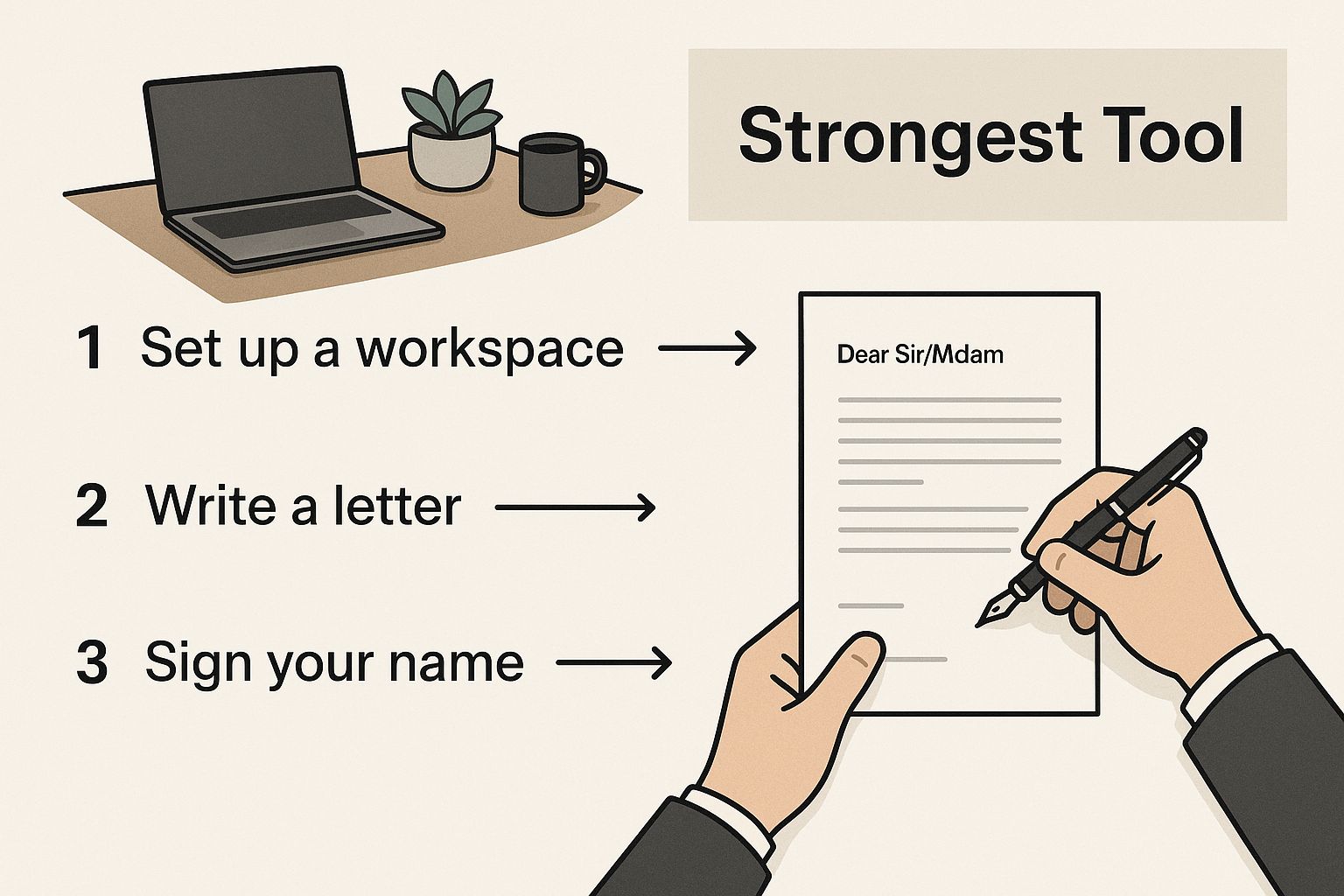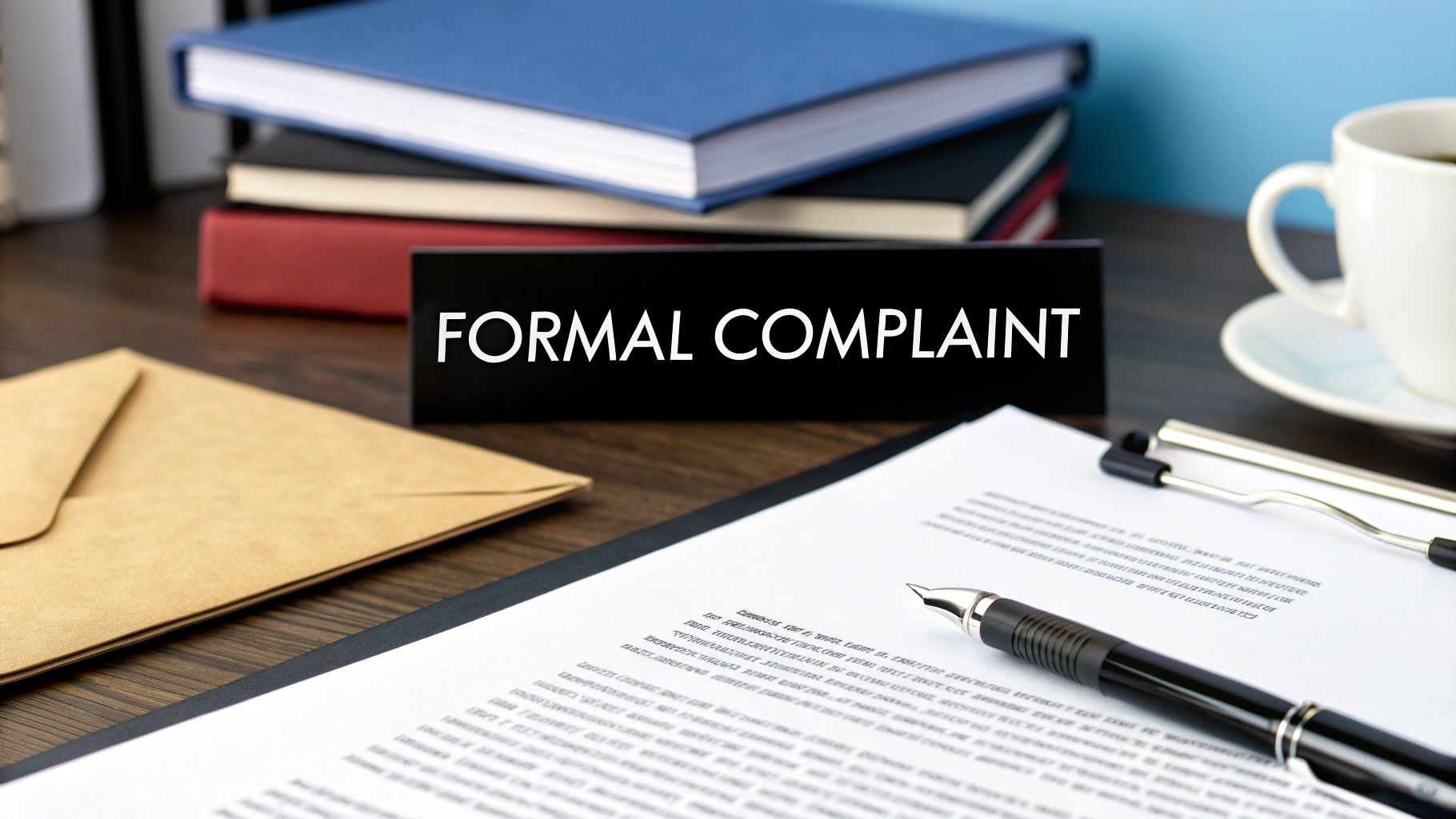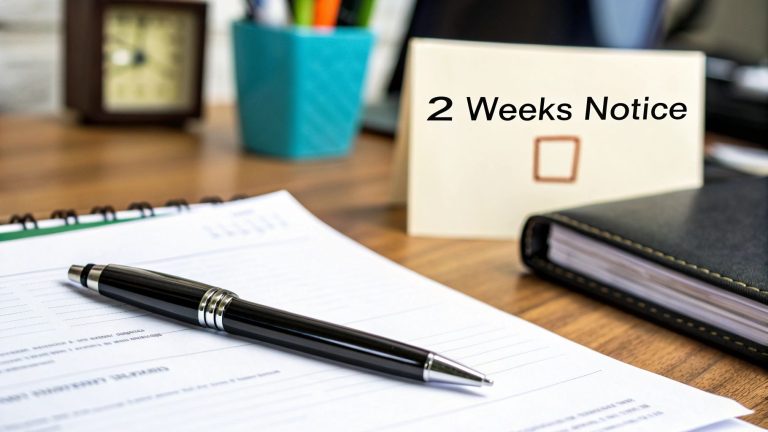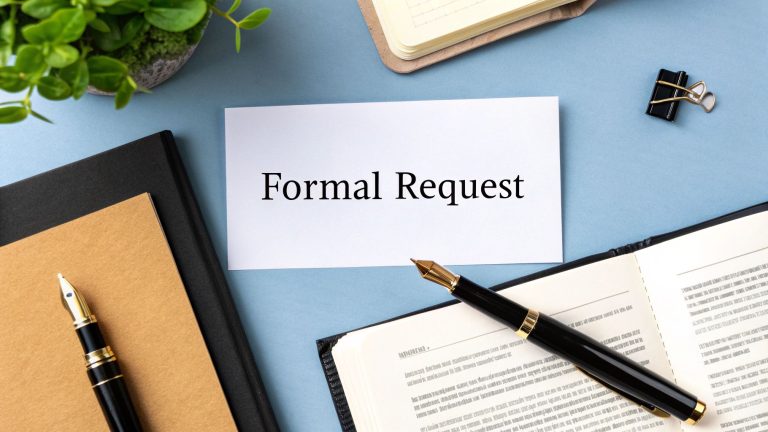When you've tried everything else and gotten nowhere, a formal complaint letter template is your best friend. It gives you a solid framework to build an undeniable record of your issue, showing the company you mean business and protecting your legal rights. It might seem old-fashioned, but it's often the most powerful tool for getting the resolution you deserve.
Why a Formal Letter Is Still Your Strongest Tool
Before we dive into the template itself, let's talk about why this approach works so well, especially when calls and emails have failed. In a world saturated with instant messages and fleeting digital chats, a physical letter carries a different kind of weight. It shows you’ve taken the time to think through and document your problem, which immediately gets the attention of people who can actually make decisions.
Think of it as creating an official paper trail. A letter is tangible proof that you’ve formally reported the problem. The U.S. Federal Trade Commission even points to formal letters as a key step in preserving your legal rights, creating a written record of your concerns. That documentation becomes invaluable if you need to take things further. You can read more on effective complaint strategies in the FTC's official guidance.
This infographic really drives home why a formal complaint is such a powerful move.

As you can see, a physical letter cuts through the digital noise and demands to be taken seriously.
A Real-World Scenario
I once worked with someone who was stuck in a warranty dispute over a faulty dishwasher for months. They sent countless emails that went unanswered and spent hours on frustrating phone calls. Finally, they sent a detailed formal letter. It laid out every single communication attempt, had copies of receipts attached, and gave a firm deadline for a resolution.
The result? Within one week, the company's customer relations manager called them personally to apologize and arrange a full replacement. The letter bypassed the standard runaround and landed on the desk of someone with the authority to fix the problem.
That shift didn't happen by magic. It happened because the letter was impossible to ignore. It signaled serious intent and professionalism, turning a frustrating back-and-forth into a clear path to a solution. Learning the art of professional letter writing is a skill that pays dividends, and this guide will give you the tools you need to master it.
The Anatomy of a Complaint Letter That Gets Results

When you write a complaint letter, you're not just venting—you're building a case. The way you structure your argument is just as important as the words you choose. A good structure makes your message clear, professional, and much harder to ignore.
Think of it as a blueprint. Every effective letter follows a logical path, guiding the reader from understanding the problem to seeing your proposed solution. Skipping a step can derail the whole thing. Let's walk through the essential parts that make a complaint letter truly effective.
H3: Nailing the Basics: Contact Info and Recipient Details
This might seem like a no-brainer, but you'd be surprised how many people get it wrong. Start with your full name, address, email, and a good contact phone number.
Then, add the date you're writing the letter. Below that, list the recipient's details: their name, professional title, and the company's full address. Trust me, sending a letter to a specific "Customer Service Manager" gets a lot more attention than one addressed to a generic "To Whom It May Concern." It shows you’ve done your homework.
Getting this part formatted correctly sets a professional tone right from the start. If you need a refresher on standard business layouts, check out our guide on how to format a letter.
H3: Building Your Case: The Body of the Letter
This is where you lay out your argument. To make it as clear and powerful as possible, break it down into three distinct sections.
-
The Opener: Don't beat around the bush. State exactly why you're writing in the first paragraph. Be sure to include critical details like your account number, an invoice number, or the product's serial number. For instance: "I am writing to formally complain about the faulty television (Model X, Serial #12345) I purchased on October 26, 2024."
-
The Story: Next, tell them what happened. Walk them through the timeline of events chronologically, sticking to the facts. Avoid overly emotional language—it only weakens your position. Mention the date of purchase, when the issue occurred, and any contact you’ve already had with their support team.
-
The Solution: This is crucial. End your letter by stating precisely what you expect as a resolution. Don't be vague. Do you want a full refund? A replacement? A repair? Proposing a clear and reasonable solution makes it incredibly easy for the company to give you what you want.
Key Takeaway: The most effective letters follow a simple, logical flow: "Here's who I am," then "Here's what happened," and finally, "Here's what I want." This progression is the backbone of any complaint letter that actually solves a problem.
Here’s a simple table breaking down what each part of your letter should accomplish.
| Section | Purpose | What to Include |
|---|---|---|
| Contact Information | To establish who you are and how to reach you. | Your full name, address, email, phone number, and the date. |
| Recipient’s Details | To ensure the letter reaches the right person. | Recipient’s name, title, company name, and full company address. |
| Opening Paragraph | To state the purpose of the letter immediately. | A clear statement of the complaint with reference numbers (invoice, account, etc.). |
| Narrative/Body | To provide a factual, chronological account of the issue. | A timeline of events, dates, and a summary of previous communications. |
| Resolution/Closing | To propose a specific and reasonable solution. | A clear request for a refund, replacement, repair, or other specific action. |
Following this structure helps you stay focused and ensures the person reading your letter understands exactly what went wrong and how they can make it right.
Your Go-To Formal Complaint Letter Template
Alright, let's get down to business. Here is a battle-tested, fill-in-the-blanks template you can grab and adapt for just about any complaint you need to make. Whether it’s a product that died prematurely, service that missed the mark, or a mysterious charge on your bill, this structure gives you a solid, professional starting point.
A good complaint letter is all about clear, structured communication. It's a lot like creating a project plan—having the right framework makes all the difference. For instance, using a free communication plan template can get an entire team aligned. This letter template does the same thing for your complaint: it organizes your thoughts for maximum impact.
This format is intentionally flexible. Just swap out the details to fit your situation. And if you're short on time, our free formal letter generator can whip up a polished draft for you in a snap.
The Fill-in-the-Blanks Template
[Your Full Name]
[Your Street Address]
[Your City, State, Zip Code]
[Your Email Address]
[Your Phone Number]
[Date]
[Recipient's Name]
[Recipient's Title (e.g., Customer Service Manager)]
[Company Name]
[Company's Street Address]
[Company's City, State, Zip Code]
Subject: Formal Complaint Regarding [Product/Service and Reference Number, e.g., Invoice #12345]
Dear [Mr./Ms./Mx. Last Name],
I am writing to formally complain about a [Product Name or Service] I purchased on [Date of Purchase] at [Location of Purchase, if applicable]. My [Account/Order/Serial Number] is [Your Number]. The issue I have encountered is [briefly and clearly state the problem in one or two sentences].
On [Date the problem occurred], [provide a clear, chronological account of what happened. Stick to the facts. Mention any steps you have already taken, such as calls or emails, including the dates and names of people you spoke with]. Despite my efforts to resolve this through [previous channels, e.g., customer support calls], the issue remains unresolved.
Pro Tip: Keep your timeline concise and factual. Avoid emotional language and focus on the sequence of events. For example, "On November 5th, I spoke with Jane in customer service, who advised me to…" is much stronger than "I was so angry after wasting my time on the phone."
To resolve this problem, I would appreciate a [state your desired resolution, e.g., full refund, replacement product, repair at no charge]. I have attached copies of my [list of attached documents, e.g., receipt, warranty, photos of the damage] to support my claim.
I look forward to your reply and a resolution to my problem. I will wait until [provide a specific date, e.g., two weeks from the date of the letter] before seeking further assistance. Please contact me at the phone number or email address listed above.
Sincerely,
[Your Signature (for printed letters)]
[Your Typed Name]
How to Make Your Complaint Letter Impossible to Ignore

Starting with a template is smart, but it's the specific details and evidence you include that will turn your complaint from a routine letter into an undeniable demand for action. The real power is in how you build your case.
The most crucial strategy has nothing to do with what you write, but how you write it. Always maintain a calm and professional tone. It’s easy to let frustration take over, but an angry letter is easy to dismiss. Stick to the facts, present your case logically, and let the evidence do the heavy lifting. This approach immediately shows you’re a reasonable person looking for a fair resolution, not just venting.
Arm Your Letter with Proof
Evidence is your best weapon. A complaint backed by solid documentation is far more compelling than one that relies on memory alone. Your goal is to create a complete packet of proof they simply can't argue with.
Before you send anything, gather your supporting documents. Here’s a quick checklist of what to include:
- Receipts and Invoices: These are your non-negotiable proof of purchase, showing dates and amounts.
- Photos or Videos: Is the product damaged? Is the work shoddy? Visual evidence is incredibly persuasive.
- A Communication Log: Briefly summarize any previous calls or emails. Note the date, time, and the name of the person you spoke with.
Attaching these documents proves you’re organized, serious, and have a well-documented claim. In my experience, this level of preparation often leads to a much faster and more positive response.
Your complaint letter isn't just a letter; it’s a formal record. For critical issues, you need to prove it was delivered. Learning how to send a certified letter gives you a delivery receipt, which can be invaluable if you need to escalate the matter.
Set Clear Expectations
Finally, don't leave the next steps up to chance. Be direct and state a reasonable deadline for their response— 10 to 14 business days is usually a fair timeframe.
You can also hint at your next steps without sounding aggressive. A simple line like, "I will wait until [Date] for your response before seeking further assistance," adds a sense of urgency. It’s a firm but polite way to show you mean business.
Of course, the clearer and more concise your writing is, the better your results will be. Taking some time to improve writing skills is always a great investment, especially when you need to communicate something important.
Common Mistakes That Get Your Letter Ignored
Even the best-written complaint can end up in the trash bin if you make a few simple mistakes. It happens all the time. After all that effort, your letter needs to land in the right hands.
One of the biggest blunders is sending your letter into a black hole. Addressing it to a generic "Customer Service" department or firing it off to an "info@" email is a gamble. It’s far too easy for it to get lost in the daily flood of messages.
Another pitfall? Being unclear about what you actually want. Just saying you're "unhappy" doesn't give the company anything to work with. You need to be crystal clear about your desired outcome. Do you want a full refund, a replacement product, or a specific repair? Tell them exactly what will make things right.
Vague Demands and Missing Details
I've seen so many people forget the most basic details, and it stalls everything. Always, always include your account number, invoice ID, or the product serial number. Without those key identifiers, the support team can't even pull up your file, let alone start looking into your problem.
This is especially true for big industries like finance. Think about it: UK firms alone received about 1.78 million complaints in the second half of 2024. With that kind of volume, they need precise data just to keep track of everything. You can read more about these UK financial services complaint trends and see for yourself why clarity is king.
Key Takeaway: Resist the urge to use aggressive or threatening language. I know you're frustrated, but keeping a professional and calm tone builds credibility. It genuinely makes people want to help you.
Got Questions? Here Are Some Answers
Wading into a formal complaint can bring up a lot of questions. It's easy to feel like you're sending your letter into a black hole, but knowing a few tricks of the trade can make a huge difference.
Do I Really Need to Use Certified Mail?
For anything serious, yes, you absolutely should. Think of certified mail as your insurance policy. It gives you a delivery receipt, which is concrete proof the company got your letter.
Why does this matter? Because if things escalate, they can't pull the old "we never received it" excuse. That little piece of paper becomes invaluable, and it’s a small price to pay for that kind of leverage.
What if They Just Ignore Me?
It happens. You wait patiently, your deadline comes and goes, and… crickets. Don't throw in the towel.
Your next move is a follow-up letter. Reference your original complaint and mention the certified mail receipt. Politely but firmly state that if you don't hear back, you'll be taking your complaint to a third party like the Better Business Bureau or a state consumer protection agency.
You're not alone in this, by the way. It’s a huge issue. A 2023 survey revealed that a staggering 38% of consumers had to file a formal complaint in the past year. This just goes to show how often a well-structured letter is the only way to get a company’s attention. You can see the full breakdown of these global complaint trends for yourself.
Finding it hard to get the tone just right? The AI Letter Generator can draft a clear, professional complaint letter for you in seconds. Just plug in the details, and it builds a letter that's polished and ready to send. Give it a try for free at lettergenerator.co.




